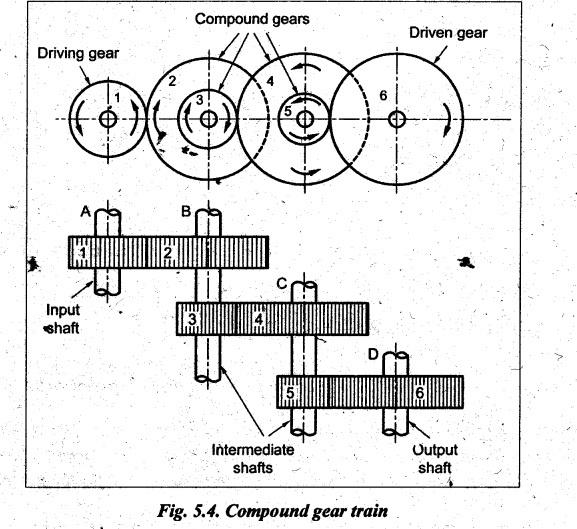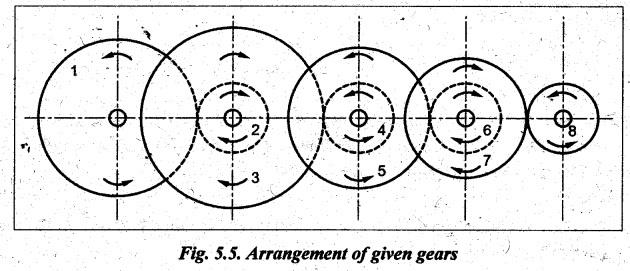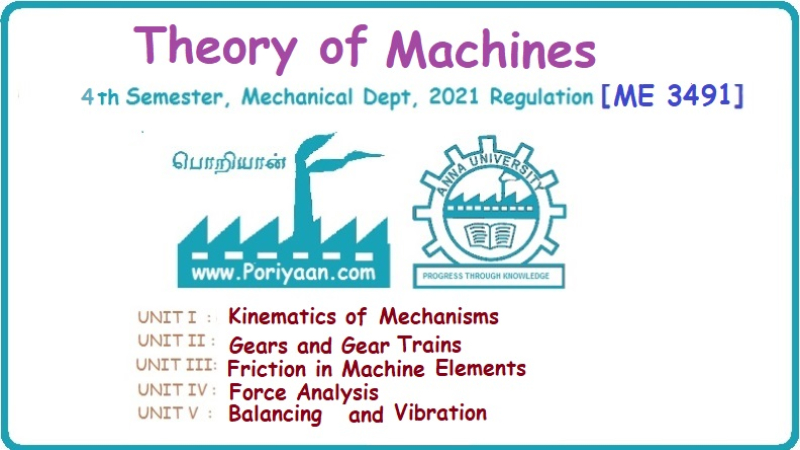Theory of Machines: Unit II: Gears and Gear Trains
compound gear Train
Gears and Gear Trains - Theory of Machines
When two gears are fixed on the same shaft, then the gears form a compound gear.
COMPOUND GEAR TRAIN • When two gears are fixed on the same shaft, then the gears form a compound gear. • A gear train having one or more compound gears is known as compound gear train. • The advantage of compound gear train over simple gear train is that it can provide higher speed reductions, for the given centre distance between the input and output shafts, using smaller gears. • There are many applications that require lower output shaft speeds. Generally these applications are run (input) by high speed electric motors* (say 1440 rpm). In such applications, the compound gear trains are used to achieve the required larger speed reductions.** • Fig.5.4 shows a compound gear train with two intermediate shafts. • In Fig.5.4, the gear 1 is the driving gear mounted on shaft A, gears 2 and 3 are. compound gears which are mounted on shaft B. The gears 4 and 5 are also compound gears which are mounted on shaft C and the gear 5 is the driven gear mounted on shaft D. • Though low speed electric motors are available in the market, the high speed motors are commonly used because they are comparatively smaller in size and cheaper in cost. • For such large speed reductions, simple gear train cannot be used. Because it requires smaller driving gear and very very large driven gear, which is practically not feasible. Let N1 = Speed of driving gear 1, Ꭲ1 = Number of teeth on driving gear 1, N2, N3, N4, N5 and N6 = Speed of gears 2, 3, 4, 5 and 6 respectively, and T2, T3, T4, T5 and T6 = Number of teeth on gears 2, 3, 4, 5 and 6 respectively. Multiplying the equations (i), (ii) and (iii), we get Train value or velocity ratio of the compound gear train is given by Example 5.1 Two parallel shafts are connected by a'simple gear train. The speed of the driving gear and the driven gear is 360 rpm and 120 rpm, respectively. The number of teeth on the driving gear is 30. Determine: (i) the train value, and (ii) the number of teeth on the driven gear. Given data: Simple gear train; N1 = 360 rpm; N2 = 120 rpm; T1 = 30 Solution: (i) Train value: We know that, (ii) Number of teeth on driven gear: We know that the speed ratio, Example 5.2 A compound gear train consists of six gears. The number of teeth on the gears are as follows: The gears B and C are on one shaft while the gears D and F are on another shaft. The gear A drives gear B, gear C drives gear D and gear E drives gear F. If the speed of the gear A is 100 rpm, then determine the speed of the gear F. Given data: TA = 60; TB = 40; TC = 50; TD = 25; TE = 30; TF = 24; NA = 100 rpm Solution: The arrangement of the given compound gear train is shown in Fig.5.4. We know that for a compound gear train, Example 5.3 A non-reverted compound gear train with spar gears has to be designed for a speed ratio of 300. The stock gears available have number of teeth from 15 to 75 in steps of five as 15, 20, 25, 70, 75. Minimum speed ratio of a gear pair should not be less than 3 and the gear ratios should be integers. Determine the number of teeth on each gear and sketch the arrangement. Solution: Solving the problem by trial and error method, we get the following combination of gears in a compound gear train. For the compound gear train, Thus with the selected gears combinations, we get the required design speed ratio of 300. The gear train arrangement can be drawn as shown in Fig.5.5.
1. Train Value of Compound Gear Train











Theory of Machines: Unit II: Gears and Gear Trains : Tag: : Gears and Gear Trains - Theory of Machines - compound gear Train
Related Topics
Related Subjects
Theory of Machines
ME3491 4th semester Mechanical Dept | 2021 Regulation | 4th Semester Mechanical Dept 2021 Regulation
